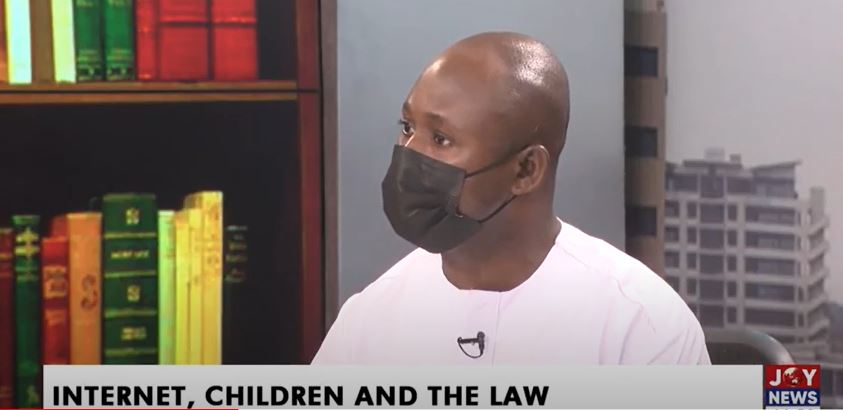An Information Security Consultant, Alex Oppong, has disclosed that many social media platforms have exposed children between ages 9 and 17 years to pornographic contents.
He noted that in most instances, these children receive and send videos and photos to people they have not met before on social media, exposing them to cyber risks and dangers.
In an interview on JoyNews’ ‘The Law’, Sunday, Mr. Oppong made reference to a report by the United Nations Children’s Fund (UNICEF) which highlighted that averagely, 4 out of 10 children are not safe on the internet due to the inappropriate contents they are exposed to.
“2 out of 10 children between the ages 9 and 17 have received sexual images in words, pictures or videos through social networking sites. Your typical classroom is made up of 25 to 30 children. That means out of the 30 children, you’ve got at least 6 children who have seen these images so they are sitting in the classroom with all these weird images they’ve seen and you don’t know what is happening to them psychologically.”
“4 out of 10 have made contacts with someone on the internet they have never met before. People just receive requests of friendship without even checking to see who they are accepting it from. 2 out of 10 have met someone face-to-face that they first got to know on the internet. 4 out of 10 have seen sexual images, 5 out of 10 have experienced things that upset or bothered them online,” he added.
Need for parents to be tech-savvy
Alex Oppong says parents must strive to understand the types of technologies and online applications their children use in order to provide better surveillance and monitoring over what they do on such sites.
He explained that parents must endeavour to know the kinds of communications their children have with their peers and people they meet online to ensure they do not land cyber security troubles.
“If our children are seeing these images and vidoes, what controls do we have to put in place? There are a number of tools that you could use to basically protect your child and allow them to enjoy the online experience. Those tools are based a lot on parental controls.”
“What that means is as a parent, it’s our responsibility to be tech-savvy about these social media applications. If you are not savvy enough, how do you put your parental controls in place and protect your children from the kind of images they are seeing?” he quizzed.
What the Cybersecurity Act says
The Cybersecurity Act, 2020 (Act 1038) states that “a person shall not use a computer online service, an internet service, or a local internet bulletin board service or any other electronic device to compile, transmit, publish, reproduce, buy, sell, receive, exchange, or disseminate the name, telephone number, electronic mail address, residence address, picture, physical description, characteristics, or any other identifying information on a child in furtherance of an effort to arrange a meeting with the child for the purpose of engaging in sexual intercourse, sexually explicit conduct, or unlawful sexual activity.”
It continues to add that any person who goes against this provision “commits an offence and is liable on summary conviction to a term of imprisonment of not less than five years and not more than 15 years.”
Latest Stories
-
Prof Gyampo called and texted OSP during raid on SML – OSP claims
25 minutes -
Nigeria sprinter Favour Ofili switches allegiance to Turkey
26 minutes -
Ahwoi and Bartels-Kodwo families open residence to mourners following passing of Ama Adoma Bartels-Kodwo
29 minutes -
Mpox Outbreak: Western Regional Health Directorate springs into action
54 minutes -
OSP rebuts Gyampo’s ‘vendetta’ allegation over investigation into Ofori-Atta
2 hours -
Ukraine still holds ground inside Russia’s Kursk, commander says
2 hours -
Nkwanta South MCE pays courtesy call on national Chief Imam, seeks prayers for peace
3 hours -
Kwasi Sibo helps power Real Oviedo to LaLiga promotion after 24-year wait
3 hours -
Broadcast and Build: How 2 of Ghana’s leading media giants are driving a bold socio-economic reset through strategic trade fairs
3 hours -
Actress Kalsoume Sinare named Ghana’s ambassador to Spain
4 hours -
Nkyinkyim says band music pays, but only with proper investment
5 hours -
Ecobank-JoyNews Habitat Fair: Day 3 promises mouth-watering discounts and great sales
5 hours -
Parents now request music lessons for their children from us – Nkyinkyim band
5 hours -
Arthur K slams NPP for ‘acting in the interest of a small cabal’
5 hours -
Veronica Kumi Yeboah Organises Career Guidance Fair for Students in Tano North
5 hours

